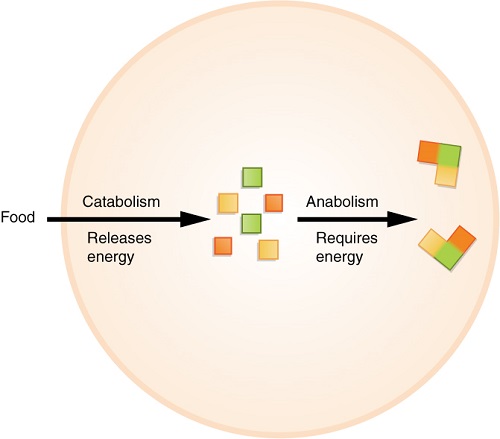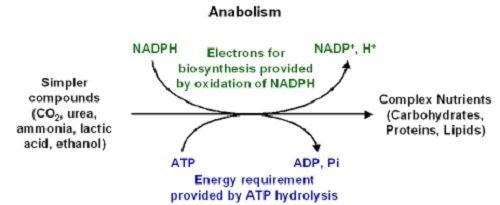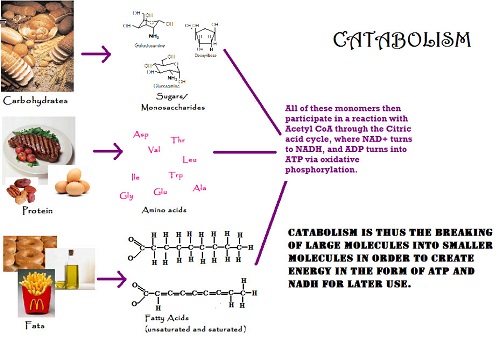Differences between Catabolism and Anabolism
The totality of an organism’s chemical reactions, that happen in cells to sustain its life is known as metabolism. Metabolism is a property of life, arising from orderly interactions between molecules. These processes enable organisms to grow, reproduce, respond to their environment and maintain their structures1.
Metabolism is divided into two general types of reactions. Broadly speaking, catabolism is all of the chemical reactions that break down molecules. This is either to extract energy, or to produce simple molecules that then construct others. Anabolism refers to all metabolic reactions that build or assemble more complex molecules from simpler ones1.
The processes of Catabolism and Anabolism
All anabolic processes are constructive, using basic molecules within an organism, which then create compounds that are more specialized and complex. Anabolism is also known as ‘biosynthesis’, whereby an end product is created from a number of components. The process requires ATP as a form of energy, converting kinetic energy into potential energy. It is considered an endergonic process, meaning it is a nonspontaneous reaction, that requires energy2. The process uses up energy to create the end product, such as tissues and organs. These complex molecules are required by the organism, as a means of growth, development and cell differentiation3. Anabolic processes do not use oxygen.
Catabolic processes on the other hand are destructive, where more complex compounds are broken down and energy is released in the form of ATP or heat – instead of consuming energy as in anabolism. Potential energy is converted into kinetic energy from stores in the body. This results in the formation of the metabolic cycle, whereby catabolism breaks down the molecules that are created through anabolism. An organism then often uses many of these molecules, which are used again in a variety of processes. Catabolic processes do utilize oxygen.
At a cellular level, anabolism uses monomers to form polymers, resulting in the formation of more complex molecules. A common example is the synthesis of amino acids (the monomer) into larger and more complex proteins (the polymer). One of the most common catabolic processes is digestion, where ingested nutrients are converted into more simple molecules, that an organism can then use for other processes.
Catabolic processes act to break down many different polysaccharides, such as glycogen, starches and cellulose. These are converted into monosaccharides, which include glucose, fructose and ribose, used by organisms as a form of energy. Proteins that are created by anabolism, are converted to amino acids through catabolism, for further anabolic processes. Any nucleic acids in DNA or RNA, become catabolized into smaller nucleotides, that are a component of the natural process of healing as well as used for energetic needs.
Organisms are classified on the basis of type of Catabolism they use4:
- Organotroph → An organism that acquires its energy from organic sources
- Lithotroph → An organism that acquires its energy from inorganic substrates
- Phototroph → An organism that acquires its energy from sunlight
Hormones
Many metabolic processes that occur within an organism are regulated by hormones. Hormones are chemical compounds, that are generally classified as either an anabolic or catabolic hormones, depending upon their overall effect.
Anabolic hormones:
- Estrogen: A hormone that exists in both females and males. It is predominantly produced in the ovaries and primarily regulates feminine sexual characteristics (such as hips and breast growth), and has also been found to affect bone mass5 and regulation of the menstrual cycle6.
- Testosterone: A hormone that exists in both males and females. It is predominantly produced within testes and primarily regulates masculine sexual characteristics (such as voice and facial hair), strengthening bone mass7 and helps build and maintain muscle mass8.
- Growth hormone: A hormone that is created within the pituitary, growth hormone stimulates and subsequently regulates growth of the organism in early life. Following maturity in adult life, it also regulates bone repair9.
- Insulin: Beta cells create this hormone within the pancreas. It regulates glucose levels and use in the blood. Glucose is a primary source of energy, however it is unable to be processed without insulin. If the pancreas struggles or is unable to produce insulin, it can lead to diabetes10.
Catabolic hormones:
- Glucagon: Produced within the pancreas by alpha cells, glucagon is responsible for stimulating breakdown of glycogen stores into glucose. Glycogen exists in reservoirs stored in the liver and when the body needs more energy (such as exercise, high stress levels or fighting), glucagon stimulates catabolism of glycogen, resulting in glucose entering the blood10.
- Adrenaline: Also known as ‘epinephrine’, it is created within adrenal glands. Adrenaline plays a fundamental component in a physiological reaction called ‘fight or flight’. During the physiological response, the bronchioles open up and heart rate is accelerated for enhanced oxygen absorption. It is also responsible for flooding glucose into the body, thereby providing a fast source of energy11.
- Cortisol: Also called ‘stress hormone’, it is synthesized in adrenal glands. When an organism experiences anxiety, prolonged discomfort or nervousness, cortisol is released. Blood pressure increases as a result, a spike in the level of blood sugar is incurred and the immune system becomes suppressed12.
- Cytokine: A very small protein hormone that regulates interactions and communication between cells in the body. There is a constant production of cytokines, that are also consistently broken down, with amino acids reused by the organism. A common example is lymphokines and interleukin, where they are released after an immune response is incurred following invasion by a foreign body (bacteria, virus, tumor or fungus) or after an injury13.
Catabolic and Anabolic processes during exercise
An organism’s body weight is determined by catabolism and anabolism. Essentially, the amount of energy released through anabolism, minus the amount used through catabolism equals its overall weight. Any excess energy not burned through catabolism is stored in the form of glycogen or fat in liver and muscle reserves14. While this is a simplified explanation of how the two processes interact, it makes it easier to understand how certain catabolic and anabolic exercises combine to determine body weight.
Anabolic processes usually result in an increase in muscle mass, such as isometrics or weight lifting15. However, any other exercise that is anaerobic, such as sprinting, interval training and other high intensity activities, are also anabolic16. During periods of such activities, the body expends immediate stores of energy, with removal of lactic acid that has been built up in muscles2. In response, muscle mass is increased in preparation for any further efforts. This means catabolic processes result in larger, stronger muscles, as well as strengthened bones and increased protein reserves by using amino acids, all combining to increase body weight17.
Typically, any exercise that is aerobic is a catabolic process. These include swimming, jogging and cycling, and other exercises that induce a conversion from using either glucose or glycogen as an energy source, to burning fat to meet the increased energy requirement18. Time is crucial in inciting catabolism, as it must burn through glucose/glycogen reserves first19. While both are key to a reduction in body fat mass, anabolism and catabolism are contrasting metabolic processes that result in either an increase or decrease in overall body weight. A combination catabolic and anabolic exercises allow the body to reach and maintain ideal body weight.
| Catabolism | Anabolism | |
| Definition | Metabolic processes that break down simple substances into complex molecules | Metabolic processes that break down larger, complex molecules into smaller substances |
| Energy | – Releases ATP energy
– Potential energy converted into kinetic energy |
– Requires ATP energy
– Kinetic energy converted into potential energy |
| Reaction type | Exergonic | Endergonic |
| Hormones | Adrenaline, Glucagon, Cytokines, Cortisol | Estrogen, Testosterone, Growth hormone, Insulin |
| Importance | – Provides energy for anabolism
– Heats the body – Enables muscle contraction |
– Supports new cell growth
– Supports storage of energy – Body tissue maintenance |
| Oxygen | Utilizes oxygen | Does not utilize oxygen |
| Effects on exercise | Catabolic exercises are usually aerobic and are good at burning calories and fat | Anabolic exercises, often anaerobic in nature and are generally muscle mass building |
| Examples | – Cell respiration
– Digestion – Excretion |
– Assimilation in animals
– Photosynthesis in plants |
Conclusion
Collectively, catabolism and anabolism are the two components of metabolism. The key fundamental difference between the two processes, are the reaction types that are involved in each.
Anabolism utilizes ATP as a form of energy, converting kinetic energy into potential energy stored in the body, which increases body mass. It produces endergonic processes, that are anaerobic, occurring during the process of photosynthesis in plants, as well as assimilation in animals.
Catabolism releases energy, either as ATP or heat, converting stored potential energy into kinetic energy. It burns complex molecules and decreases body mass and produces exergonic processes, that are aerobic and occur during cell respiration, digestion, and excretion.
- Difference between Blastula and Gastrula - November 23, 2017
- Difference between Manta Ray and Stingray - October 21, 2017
- Differences between Catabolism and Anabolism - August 29, 2017
Search DifferenceBetween.net :
1 Comment
Leave a Response
References :
[0]Urry, L. A., Cain, M. L., Wasserman, S. A., Minorsky, P. V. & Reece, J. B. (Pearson, 2017). Campbell Biology.
[1]Murray, R. K., Granner, D. K., Mayes, P. A. & Rodwell, V. W. (2003). Harper’s Illustrated Biochemistry. Molecular Physiology 16(1),
[2]de Bolster, M. W. G. (1997). Glossary of Terms Used in Bioinorganic Chemistry: Catabolism. Available at: http://www.chem.qmul.ac.uk/iupac/bioinorg/CD.html#8. (Accessed: 9th August 2017)
[3]Eiler, A. (2006). Evidence for the ubiquity of mixotrophic bacteria in the upper ocean: implications and consequences. Appl. Environ. Microbiol. 72(12), 7431–7
[4]Schiessl, H., Frost, H. . & Jee, W. S. . (1998). Estrogen and Bone-Muscle Strength and Mass Relationships. Bone 22(1), 1–6
[5]Brisken, C. & O’Malley, B. (2010). Hormone action in the mammary gland. Cold Spring Harb. Perspect. Biol. 2(12), a003178
[6]Katznelson, L. et al. (1996). Increase in bone density and lean body mass during testosterone administration in men with acquired hypogonadism. J. Clin. Endocrinol. Metab. 81(12), 4358–4365
[7]MOORADIAN, A. D., MORLEY, J. E. & KORENMAN, S. G. (1987). Biological Actions of Androgens. Endocr. Rev. 8(1), 1–28
[8]Ranabir, S. & Reetu, K. (2011). Stress and hormones. Indian J. Endocrinol. Metab. 15(1), 18–22
[9]Voet, D. & Voet, J. G. (2011). Biochemistry.
[10]Lieberman, M., Marks, A. & Peet, A. (Wolters Kluwer Health/Lippincott Williams & Wilkins, 2013). Marks’ Basic Medical Biochemistry: A Clinical Approach.
[11]Hoehn, K. & Marieb, E. N. (Benjamin Cummings, 2010). Human Anatomy & Physiology.
[12]Lackie, J. (Oxford University Press, 2010). in A Dictionary of Biomedicine
[13]Galgani, J. & Ravussin, E. (2008). Energy metabolism, fuel selection and body weight regulation. Int. J. Obes. (Lond). 32 Suppl 7(Suppl 7), S109-19
[14]Yang, Y. et al. (2012). Resistance exercise enhances myofibrillar protein synthesis with graded intakes of whey protein in older men. Br. J. Nutr. 108(10), 1780–1788
[15]Kraemer, W. et al. (1991). Endogenous Anabolic Hormonal and Growth Factor Responses to Heavy Resistance Exercise in Males and Females. Int. J. Sports Med. 12(2), 228–235
[16]Tipton, K. D., Elliott, T. A., Ferrando, A. A., Aarsland, A. A. & Wolfe, R. R. (2009). Stimulation of muscle anabolism by resistance exercise and ingestion of leucine plus protein. Appl. Physiol. Nutr. Metab. 34(2), 151–161
[17]Schulze, P. C., Gielen, S., Schuler, G. & Hambrecht, R. (2002). Chronic heart failure and skeletal muscle catabolism: effects of exercise training. Int. J. Cardiol. 85(1), 141–149
[18]Tegtbur, U., Busse, M. W. & Braumann, K. M. (1993). Estimation of an individual equilibrium between lactate production and catabolism during exercise. Med. Sci. Sports Exerc. 25(5), 620–7
[19]https://en.wikibooks.org/wiki/Structural_Biochemistry/Catabolism
[20]https://chem.libretexts.org/Core/Biological_Chemistry/Metabolism
[21]https://opentextbc.ca/anatomyandphysiology/chapter/1-3-functions-of-human-life-2/




Thanks to help me